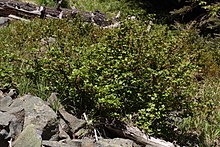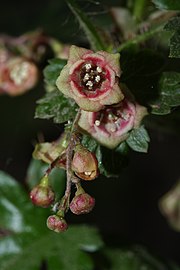|
Ribes lacustre
The shrub Ribes lacustre is known by the common names prickly currant, black swamp gooseberry, and black gooseberry.[3] It is widely distributed in North America. DescriptionThe shrub grows erect to spreading, .5–2 metres (1+1⁄2–6+1⁄2 feet). Clusters of reddish to maroon flowers bloom from April through August.[4] Racemes of 5 to 15 pink disk-shaped flowers hang from stems covered with short hairs, bristles and spines.[5] The fruit consists of dark purple berries 6–8 millimetres (1⁄4–5⁄16 inch) long. Distribution and habitatIt is widely distributed, from California to Alaska and across North America east to Pennsylvania and Newfoundland, and south as far as New Mexico.[6] It may be found in low-elevation forests and swamps all the way up to the subalpine.[4] Outside its native range, Ribes species may be invasive. Ribes is considered to be an extremely hardy species, capable of tolerating a wide range of soil types and conditions; as evidenced by its wide distribution.[7] See alsoReferences
External linksWikimedia Commons has media related to Ribes lacustre.
|
||||||||||||||||||||||||||||||||||




